NG-CryoIrTel: Next Generation-Cryogenic cooled Infrared Telescope
Mission Justification
To reveal the origin and evolution of galaxies, stars and planets is one of the ultimate goals of astronomy. To achieve the goal, observations in the mid- and far-infrared are essential, since it is in this range that astronomical objects emit most of their radiation as they form and evolve in regions where obscuration by dust prevents observations in the visible and near infrared.
Over the past quarter of a century successive space infrared observatories (IRAS, IRTS, ISO, Spitzer, AKARI) have revolutionised our understanding of the evolution of stars and galaxies. Mid- to far-infrared observations have led to stunning discoveries such as the Ultra Luminous Infrared Galaxies (ULIRGS), the basic processes of star formation from "class 0" pre-stellar cores through to the clearing of the gaseous proto-planetary discs, and the presence of dust excesses around main sequence stars.
The Herschel Space Observatory launched in 2009 extends this work in the far-infrared and sub-mm, and JWST, due for launch in 2018, will provide a major boost in observing capability in the 2 – 28 μm range. Although Herschel and JWST are powerful missions, they have some constraints for the observations in the mid- and far-infrared.
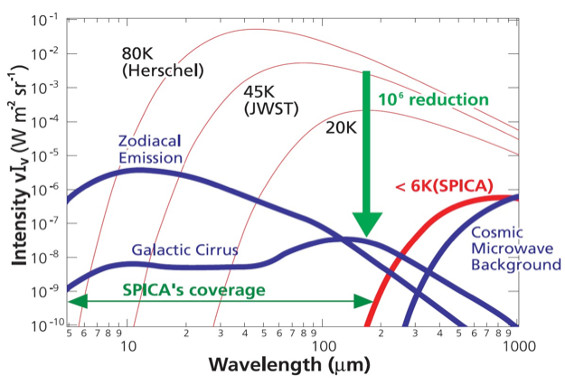 |
| Comparison of natural backgrounds (zodiacal emission, Galactic cirrus, and cosmic microwave background radiation) with those of thermal radiation from telescopes as a function of temperature. Credit: SPICA consortium. |
The thermal radiation of telescopes onboard Herschel and JWST (if it is used for the far-infrared) is brighter than natural background radiation by a factor of one million in the far-infrared. Hence their sensitivity in the far-infrared could be degraded by a factor of one thousand from that of the natural background limited observations. On the other hand, previous cryogenically cooled missions (e.g. IRAS, IRTS, ISO, Spitzer, and AKARI) had a telescope smaller than 1m. Hence, if a 3-m-class space telescope is to be cooled below 6K, huge sensitivity improvement can be expected from that of Herschel.
SPICA, which is required to be cooled below 6K, can achieve superior sensitivity by reducing the background radiation by a factor of a million from previous missions.
Hence SPICA was proposed in this context and is optimised for mid- and far-infrared astronomy with a cryogenically cooled, large telescope. SPICA was propose as an observatory that would provide imaging and spectroscopic capabilities in the 5 to 210 μm wavelength range with a 3.2 m telescope cooled to a temperature less than 6 K.
From SPICA to NG-CryoIRTel
Discussion between ISAS/JAXA and ESA in 2013 concluded that the scheme for SPICA was not compatible with a timely and robust implementation of the mission. Both JAXA and ESA believe that a more balanced sharing of responsibilities, with an enhanced ESA participation to the mission, would lead to a lower risk and to a more robust mission implementation. Any significant extension of the ESA-contributed elements would bring the mission into the medium mission range, however, with the implication that the mission would need to be proposed by the interested scientific community to an ESA call for missions where it would be peer-reviewed together with other proposals submitted to the same opportunity.
To support the European and Japanese science community in defining a post-SPICA mission for a medium (M-class) mission call, a smaller Next Generation-Cryogenic cooled IR Telescope (NG-CryoIRTel) has been assessed in a CDF study, trying to meet a set of science achievements similar to the ones proposed for the previous SPICA mission.
NG-CryoIRTel will cover the full 20 to 210 μm wavelength range, including the missing 28 μm to
Science Objectives
The main science objectives, derived from the previous SPICA study and which NG-CryoIRTel tries to enable are:
- Investigate how stars and galaxies form and evolve over cosmic ages
- Observe thousands of obscured, distant galaxies and determine the processes that govern their evolution
- Investigate how our Solar System relates to other planetary systems and how life could evolve elsewhere
- Characterise oxygen, water, ice and rocks in young planet-forming systems and study their relation to the rocks and ice in our own Solar System
Besides these objectives, the NG-CryoIRTel might also be suitable for other science cases requiring a large cryogenically cooled telescope.
Mission Requirements
The main mission requirement for this study is to accommodate a 2m class telescope, operating below 6K, on a spacecraft maximising the re-use of Planck V-Groove technology and Gaia bipods that can be separated in-orbit for the passive cooling, using active coolers provided by JAXA and re-use the service module architecture from Herschel or Euclid.
As an option, the CDF study also investigated the growth potential of the selected architecture assessing the maximum telescope size that can be accommodated on the selected V-Groove configuration.
Study Results: Baseline
| NG-CryoIRTel System Characteristics | ||
|
Impression of the NG-CryoIRTel system. Credit: ESA |
||
| Service Module – System Characteristics | ||
|
Impression of the NG-CryoIRTel service module. Credit: ESA |
||
|
Service module mass (with margin) |
Dry mass | 1332 kg |
| Total | 1644 kg (excluding launch adapter) | |
| Power | Solar Array | 14.2 m2 of "useful" solar array surface, providing 2018 W at end of life |
| Communications | X-Band | |
| Active Cooling | 8 x 20K-class 2-stage Stirling Coolers | |
| 2 x 4K-class Joule-Thomson Coolers | ||
| 2 x 1K-class Joule-Thomson Cooler | ||
| Payload Module – System Characteristics | ||
|
Impression of the NG-CryoIRTel payload module. Credit: ESA |
||
|
Payload module mass (with margin) |
Total | 920 kg (no propellant in payload module) |
| Telescope | 2m diameter on-axis Ritchey-Chrétien Silicon Carbide (SiC) telescope | |
| Structure | 3 thermal shields: Carbon Fiber Reinforced Plastic (CFRP) sandwich with aluminium honeycomb core | |
| Thermal Shell: aluminium shell or full aluminium sandwich panel | ||
| Bipod structure: 3 x 2 bipods, one made of Glass Fiber Reinforced Plastic (GFRP) to be decoupled in later stage and one made of CFRP parallel to the main GFRP one | ||
| Telescope Optical Bench: SiC plate stiffened by ribs on the back side | ||
| Instrument Optical Bench: milled stiffened aluminium plate | ||
|
Telescope: composed of Primary Mirror (M1) and Secondary Mirror (M2), a hexagonal barrel structure holding M2 and a hexapod structure connecting the barrel to M1. All elements are made of SiC except the interface elements, which are made of INVAR. |
||
| Baffle: cylindrical structure made of CFRP sandwich aluminium honeycomb core | ||
| Mechanisms | 1 Refocusing mechanism for M2 | |
| 1 Shutter mechanism | ||
| 6 Bipod hold-down & release mechanisms and latches | ||
| Attitude and Orbit Control System | 2 Fine Attitude Sensor cold unit | |
| Instruments | SAFARI Instrument: Far-Infrared Instrument | |
| SMI Instrument: Mid-Infrared Instrument | ||
Study Results: Option
| NG-CryoIRTel System Characteristics | ||
|
Impression of the NG-CryoIRTel option. Credit: ESA |
||
| Service Module – System Characteristics | ||
|
Impression of the service module for the NG-CryoIRTel option. Credit: ESA |
||
|
Service module mass (with margin) |
Dry mass | 1431 kg + 200 kg (rough estimate) for warm payload module structure |
| Total | 1744 kg +200 kg (rough estimate) for warm payload module structure (excluding launch adapter) | |
| Power | Solar Array | 14.2 m2 of "useful" solar array surface, providing 2018 W at end of life |
| Communications | X-Band | |
| Active Cooling | 8 x 20K-class 2-stage Stirling Coolers | |
| 2 x 4K-class Joule-Thomson Coolers | ||
| 2 x 1K-class Joule-Thomson Cooler | ||
| Payload Module – System Characteristics | ||
|
Impression of the payload module for the NG-CryoIRTel option. Credit: ESA |
||
|
Payload module mass (with margin) |
Total | 1271 kg (no propellant in payload module) |
| Telescope | 2.6m x 3m elliptical off-axis Ritchey-Chrétien SiC telescope | |
| Structure | 3 thermal shields: CFRP sandwich with aluminium honeycomb core | |
| Thermal Shell: aluminium shell or full aluminium sandwich panel | ||
| Bipod structure: 6 x 2 bipods, one made of GFRP to be decoupled in later stage and one made of CFRP parallel to the main GFRP one | ||
|
Telescope Optical Bench: SiC Plate stiffened by ribs on the back side |
||
| Instrument Optical Bench: milled stiffened aluminium plate | ||
|
Telescope: composed of Primary Mirror (M1) and Secondary Mirror (M2), a hexagonal barrel structure holding M2 and a hexapod structure connecting the barrel to M1. All elements are made of SiC except the interface elements which are made of INVAR. |
||
| Baffle: cylindrical structure made of CFRP sandwich aluminium honeycomb core | ||
| Mechanisms | 1 Refocusing mechanism for M2 | |
| 1 Shutter mechanism | ||
| 6 Bipod hold-down & release mechanisms and latches | ||
| Attitude and Orbit Control System | 2 Fine Attitude Sensor cold unit | |
| Instruments | SAFARI Instrument: Far-Infrared Instrument | |
| SMI Instrument: Mid-Infrared Instrument | ||
Full details can be found in the CDF study report: NG-CryoIRTel, Assessment of Next Generation Cryogenic InfraRed Telescope.

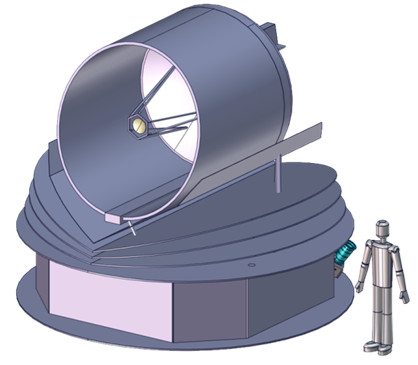
.jpg)
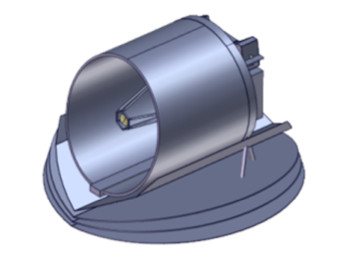
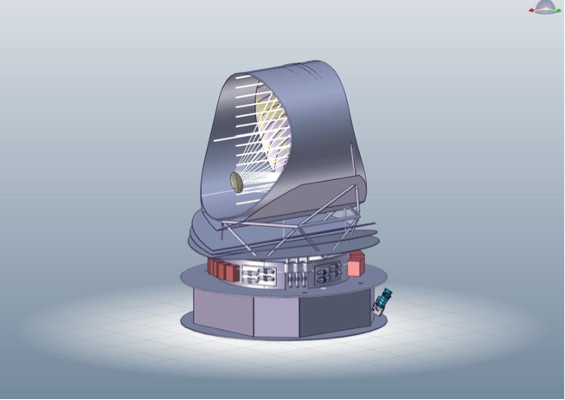
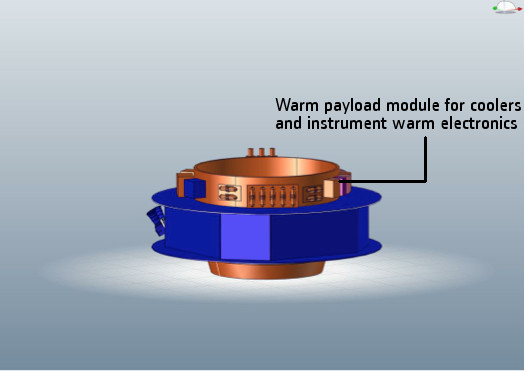
.jpg)